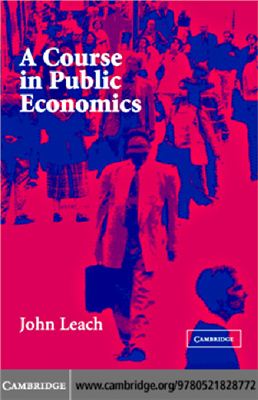400 р.
Introduction
Two Theorems
Market Failure
Information and the Second Theorem
The Usefulness of the Two Theorems
Markets
The Exchange Economy
The Edgeworth Box
Pareto Optimality
Competitive Equilibrium
Markets
The Two Fundamental Theorems ofWelfare Economics
Summary
Questions
An Algebraic Exchange Economy
Utility Functions
The Marginal Rate of Substitution
Pareto Optimal Allocations
Competitive Equilibrium
The Two Theorems
Conclusions.5 The Role of the Govement
The Production Economy
Pareto Optimality
Competitive Equilibrium
An Example of Competitive Equilibrium
The Two Theorems
Conclusions
Appendix: An Example of Production Efficiency
Questions
Consumer and Producer Surplus
Margins and Totals
Surplus
TheWelfare Cost of Intervention
Market Interactions
Conclusions
Appendix: Margins and Totals
Questions
Extealities
Extealities and Negotiation
Negotiated Compensation
Why Doesn’t Negotiation Occur?
Govement Intervention
Questions
Permit Trading
Environmental Pollution and Abatement
Direct Emissions Controls
Permit Trading
Discussion
Questions
Renewable Common Property Resources
The Static Common Property Problem
The Dynamic Common Property Problem
Extinction
Appendix: An Algebraic Example
Questions
Co-ordination Failures
A Co-ordination Game
A Co-ordination Game with Uncertainty
Conclusions
Questions
Public Goods
Pure Public Goods
Optimal Provision of a Public Good
oluntary Provision of the Public Good
s Non-Excludability the Source of the Problem?
Conclusions
Questions
Two Examples of Pure Public Goods
Knowledge
ncome Redistribution
Questions
mpure Public Goods
Club Goods
ariable-Use Public Goods
Summary
Questions
The Link between Public Goods and Extealities
nterdependent Preferences
ndifference Curves
Pareto Optimal Allocations
A Public Good
A Good with a Positive Exteality
A Good with a Negative
mperfect Competition
Monopoly
Natural Monopoly
Rent-Seeking Behaviour
Conclusions
Questions
Pricing Rules under Imperfect Competition
Marginal Cost Pricing
Undifferentiated Goods
Differentiated Goods
Taxation and Efficiency
Taxation
s Lump-Sum Taxation Possible?
The Optimal Size of Govement
Conclusions
Questions
TheWelfare Cost of Tax Interactions
A Robinson Crusoe Economy
Pareto Optimality
Competitive Equilibrium
Welfare Cost Calculations
Conclusions
Questions
The Theory of the Second Best
Optimal Taxation
Natural Monopoly and the Ramsey Pricing Rule
Conclusions
Questions
Asymmetric Information and Efficiency
Asymmetric Information
Adverse Selection
Moral Hazard
Questions
Preference Revelation
Preference Revelation in a Simple Economy
The Groves–Clarke Mechanism
Preference Revelation in Practice
Regulation of a NaturalMonopoly
Natural Monopoly with a Role for Management
Full Information
The Consequences of Asymmetric Information
Adjusting the Menu
Conclusions
Appendix: Optimal Regulation under Asymmetric Information
Questions
Other Examples of Asymmetric Information
Health Care and Health Care Insurance
The Standard Debt Contract
EfficiencyWages
Questions
Asymmetric Information and Income Redistribution
The Distribution of Income
Determinants of Income
ncome andWelfare
Reasons for Income Redistribution
Policy Options
The Limits to Income Redistribution
An Economy with Self-Selection
Redistributive Policies
Welfare and Pareto Efficient Taxation
Conclusions
Questions
Redistributing Income through Tagging and Targeting
Tagging
Targeting
Conclusions
Questions
The Role of Govement in aMarket Economy
Repair of Market Failures
Redistribution of Income
The Limits on Govement Action
Introduction
Two Theorems
Market Failure
Information and the Second Theorem
The Usefulness of the Two Theorems
Markets
The Exchange Economy
The Edgeworth Box
Pareto Optimality
Competitive Equilibrium
Markets
The Two Fundamental Theorems ofWelfare Economics
Summary
Questions
An Algebraic Exchange Economy
Utility Functions
The Marginal Rate of Substitution
Pareto Optimal Allocations
Competitive Equilibrium
The Two Theorems
Conclusions.5 The Role of the Govement
The Production Economy
Pareto Optimality
Competitive Equilibrium
An Example of Competitive Equilibrium
The Two Theorems
Conclusions
Appendix: An Example of Production Efficiency
Questions
Consumer and Producer Surplus
Margins and Totals
Surplus
TheWelfare Cost of Intervention
Market Interactions
Conclusions
Appendix: Margins and Totals
Questions
Extealities
Extealities and Negotiation
Negotiated Compensation
Why Doesn’t Negotiation Occur?
Govement Intervention
Questions
Permit Trading
Environmental Pollution and Abatement
Direct Emissions Controls
Permit Trading
Discussion
Questions
Renewable Common Property Resources
The Static Common Property Problem
The Dynamic Common Property Problem
Extinction
Appendix: An Algebraic Example
Questions
Co-ordination Failures
A Co-ordination Game
A Co-ordination Game with Uncertainty
Conclusions
Questions
Public Goods
Pure Public Goods
Optimal Provision of a Public Good
oluntary Provision of the Public Good
s Non-Excludability the Source of the Problem?
Conclusions
Questions
Two Examples of Pure Public Goods
Knowledge
ncome Redistribution
Questions
mpure Public Goods
Club Goods
ariable-Use Public Goods
Summary
Questions
The Link between Public Goods and Extealities
nterdependent Preferences
ndifference Curves
Pareto Optimal Allocations
A Public Good
A Good with a Positive Exteality
A Good with a Negative
mperfect Competition
Monopoly
Natural Monopoly
Rent-Seeking Behaviour
Conclusions
Questions
Pricing Rules under Imperfect Competition
Marginal Cost Pricing
Undifferentiated Goods
Differentiated Goods
Taxation and Efficiency
Taxation
s Lump-Sum Taxation Possible?
The Optimal Size of Govement
Conclusions
Questions
TheWelfare Cost of Tax Interactions
A Robinson Crusoe Economy
Pareto Optimality
Competitive Equilibrium
Welfare Cost Calculations
Conclusions
Questions
The Theory of the Second Best
Optimal Taxation
Natural Monopoly and the Ramsey Pricing Rule
Conclusions
Questions
Asymmetric Information and Efficiency
Asymmetric Information
Adverse Selection
Moral Hazard
Questions
Preference Revelation
Preference Revelation in a Simple Economy
The Groves–Clarke Mechanism
Preference Revelation in Practice
Regulation of a NaturalMonopoly
Natural Monopoly with a Role for Management
Full Information
The Consequences of Asymmetric Information
Adjusting the Menu
Conclusions
Appendix: Optimal Regulation under Asymmetric Information
Questions
Other Examples of Asymmetric Information
Health Care and Health Care Insurance
The Standard Debt Contract
EfficiencyWages
Questions
Asymmetric Information and Income Redistribution
The Distribution of Income
Determinants of Income
ncome andWelfare
Reasons for Income Redistribution
Policy Options
The Limits to Income Redistribution
An Economy with Self-Selection
Redistributive Policies
Welfare and Pareto Efficient Taxation
Conclusions
Questions
Redistributing Income through Tagging and Targeting
Tagging
Targeting
Conclusions
Questions
The Role of Govement in aMarket Economy
Repair of Market Failures
Redistribution of Income
The Limits on Govement Action

